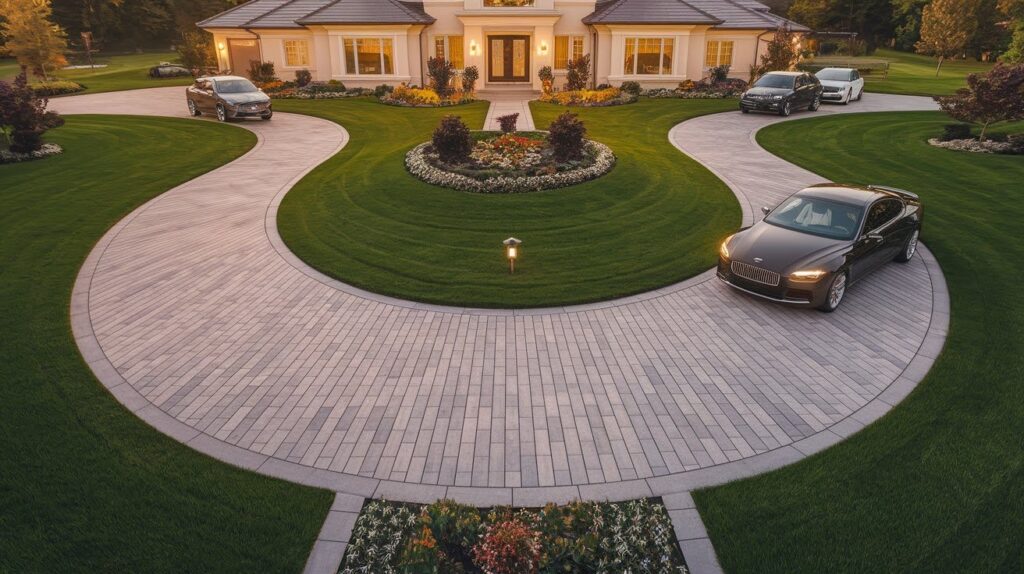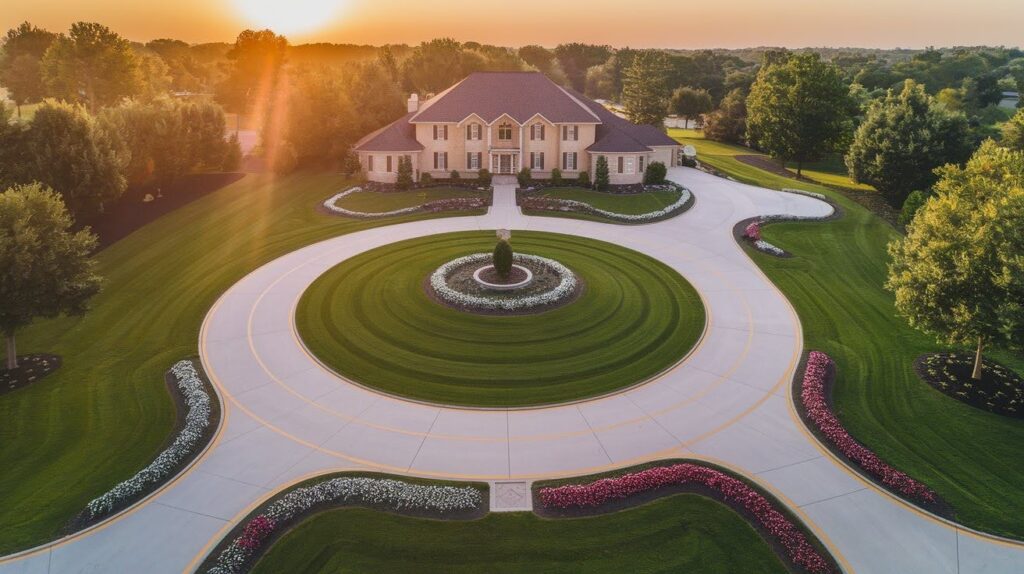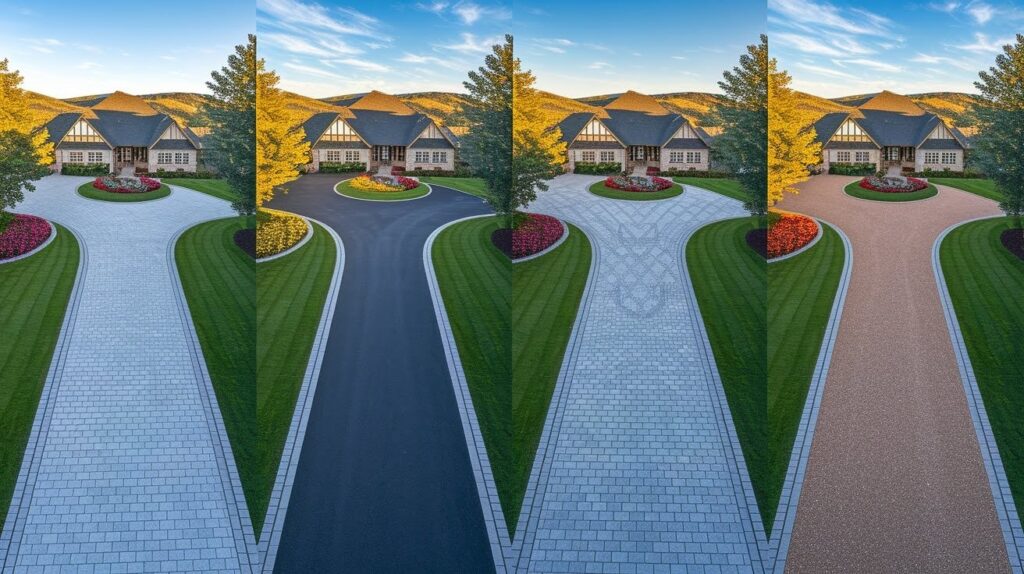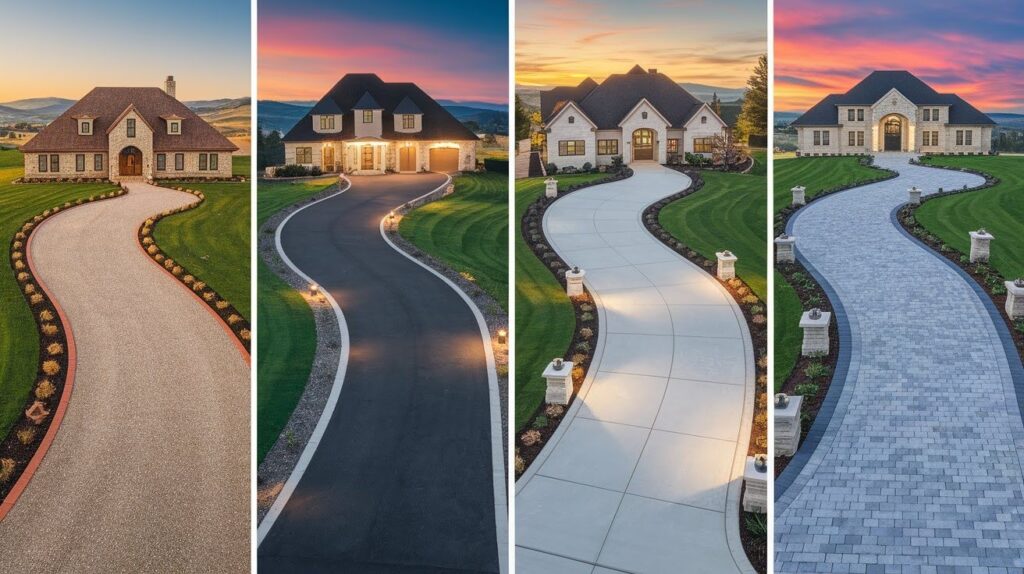After helping hundreds of homeowners redesign their properties over the past decade, I’ve seen firsthand how a horseshoe driveway can completely change a home’s character.
This curved, half-circle design creates a graceful loop that connects to your main entrance at both ends, forming an elegant crescent shape in front of your house.
What makes me recommend horseshoe driveways to my clients isn’t just their striking visual impact – though they certainly make a statement. These driveways solve real problems I see daily: difficult backing maneuvers, limited guest parking, and cramped front yards.
The circular flow eliminates dangerous reversing onto busy streets while creating natural spaces for beautiful landscaping. I’ve watched families fall in love with how this simple change transforms their home’s entire presence, making every arrival feel special.
Benefits of a Horseshoe Driveway

1. Boosts Curb Appeal
I love watching neighbors stop and admire a well-designed horseshoe driveway. The graceful, sweeping curves naturally guide your eyes toward the home’s entrance, creating an instant “wow” factor that straight driveways simply can’t match.
When I work with clients on these projects, they’re always amazed at how this single change makes their entire property look more polished and inviting.
The curved design frames your home beautifully, giving it that upscale, resort-like feeling that makes coming home feel special every single day.
2. Improves Traffic Flow
One of my favorite aspects of horseshoe driveways is how they solve everyday frustrations. With two access points, you’ll never again struggle with backing out into traffic or maneuvering around other cars.
I’ve had clients tell me it’s like having a private traffic circle – guests can drop off passengers at the front door and continue around without blocking anyone. During parties or family gatherings, multiple cars can park comfortably without the usual shuffle of moving vehicles around.
3. Increases Property Value
From my experience in real estate, homes with horseshoe driveways consistently stand out in the market. Buyers remember these properties because they offer something different. A combination of practical benefits and visual appeal that feels luxurious.
The investment pays off not just in daily convenience but also in long-term value, making it one of the smartest improvements you can make to your home’s exterior.
Design & Layout Considerations

Assessing Available Space
When I first visit a property, I always walk the frontage with my tape measure. You’ll need at least 150 feet of street frontage to create a comfortable horseshoe layout-anything less feels cramped.
I’ve learned that the key is working with your lot’s natural shape rather than fighting against it. On narrower properties, I often suggest a more elongated oval that still provides the benefits without overwhelming the space.
Driveway Width & Turning Radius
After years of designing these driveways, I’ve found that 12-14 feet width works perfectly for most families. This gives you room for comfortable two-way traffic without wasting materials.
The turning radius is where many DIY attempts go wrong – I always recommend a minimum 25-foot radius to prevent sharp, uncomfortable turns. Trust me, spending extra on a gentler curve saves you from years of careful maneuvering.
Entry Point Placement
I always coordinate with local authorities before finalizing entry points because safety regulations vary by municipality. The ideal placement offers clear sightlines in both directions, you want to see oncoming traffic easily.
I position the entry points at least 20 feet apart to create that satisfying horseshoe flow, while ensuring they meet local codes.
Material Options for Horseshoe Driveways

Concrete
I’ve installed countless concrete horseshoe driveways, and they remain my go-to recommendation for clients wanting longevity. Plain concrete might seem boring, but the decorative options available today are incredible.
Stamped concrete can mimic natural stone or brick patterns, while stained finishes add rich colors that complement your home’s exterior. Concrete handles heavy vehicles well and typically lasts 25-30 years with minimal maintenance.
Asphalt
For budget-conscious homeowners, asphalt offers excellent value without sacrificing appearance. The smooth, dark surface creates clean lines that work particularly well with modern and traditional home styles.
I always tell clients that fresh asphalt has an almost luxurious look when properly installed. The key is regular sealing every 3-5 years to maintain that rich black color and prevent cracking. It’s also the quickest installation option, most projects are driveable within 24 hours.
Pavers
When clients want something truly special, pavers are my luxury recommendation. The design possibilities are endless from classic brick patterns to contemporary geometric layouts.
I love how pavers allow for creative borders and accent areas that can tie into your home’s architecture.They’re also practical: individual pavers can be replaced if damaged, and they handle freeze-thaw cycles better than solid surfaces.
Gravel
There’s something timelessly appealing about the sound of gravel under tires. For country homes or properties with mature trees, gravel creates that perfect rustic atmosphere while being incredibly budget-friendly.
I recommend larger stones (3/4 inch) for the main surface with proper edging to prevent spreading. The maintenance is minimal, though you’ll need occasional raking and fresh stone every few years.
Maintenance Tips for Longevity
Concrete & Asphalt
- Apply sealant every 3-5 years to prevent water damage and cracking.
- Fill small cracks immediately before they expand during freeze-thaw cycles.
- Clean oil stains promptly with degreasing agents.
Pavers & Gravel
- Reset sunken or shifted pavers annually, especially after heavy rains.
- Add fresh gravel every 2-3 years to maintain proper depth and appearance.
- Pull weeds regularly or apply pre-emergent herbicide in early spring.
General Care
- Remove leaves and debris monthly to prevent staining and drainage issues.
- Pressure wash surfaces annually to maintain appearance and remove buildup.
- Check drainage during heavy rains and clear any blocked areas.
Cost Factors to Consider

Material Costs
From my experience pricing these projects, material choice makes the biggest difference in your final bill. Gravel runs about $3-5 per square foot and works great for budget-conscious families. Asphalt typically costs $4-7 per square foot, while standard concrete falls in the $6-10 range.
If you want decorative concrete with stamping or staining, expect $8-15 per square foot. Pavers are the premium option at $10-20 per square foot, but they last decades and really make a statement.
Installation Complexity
The curved nature of horseshoe driveways requires more precision than straight installations, which affects labor costs. Proper grading is critical to prevent water pooling, especially at the curve’s lowest point.
Sites with steep slopes or poor soil conditions need additional prep work, sometimes including retaining walls or extensive excavation.
Extra Features
Once the basic driveway is in, many clients get excited about additions. Landscape borders with planted areas typically add $15-25 per linear foot. Lighting systems range from $2,000-8,000 depending on fixture quality and automation features.
Decorative elements like pillars at entry points or special border treatments can add $1,000-5,000 to your project. While these features increase costs, they often provide the finishing touches that make your investment truly shine.
Final Thoughts
After decades of helping homeowners transform their properties, I can confidently say that few improvements offer the combination of style and function that a horseshoe driveway provides.
The graceful curves create an immediate visual impact while solving practical problems like traffic flow and guest parking that straight driveways simply can’t address.
My biggest piece of advice? Don’t rush the planning phase. I’ve seen too many projects fall short because homeowners skipped proper design considerations or tried to cut corners on materials.
Work with experienced professionals who understand drainage, local codes, and proper installation techniques.
Yes, it requires a significant investment upfront, but a well-executed horseshoe driveway will serve your family beautifully for decades while adding substantial value to your home. The satisfaction of pulling into your own private motor court never gets old.
Frequently Asked Questions
How much space do I need for a horseshoe driveway?
You’ll need at least 150 feet of street frontage to create a comfortable horseshoe layout. Properties with less space can consider modified oval designs that still provide improved traffic flow.
What’s the typical cost range for installing a horseshoe driveway?
Costs vary significantly based on materials and site conditions, ranging from $8,000-15,000 for gravel to $25,000-50,000 for decorative pavers. The curved design requires more precision work, which increases labor costs compared to straight driveways.
Do I need special permits for a horseshoe driveway?
Most municipalities require permits for new driveway installations, especially those with multiple access points. Check with your local building department early in the planning process to understand specific requirements and setback rules.
How long does installation typically take?
Installation usually takes 3-7 days depending on material choice and site preparation needs. Concrete and asphalt require additional curing time before you can drive on them, while gravel and pavers are immediately usable.
Will a horseshoe driveway work with my home’s architecture?
Horseshoe driveways complement most architectural styles, from colonial to contemporary homes. The key is choosing appropriate materials and proportions that match your home’s character and scale.

